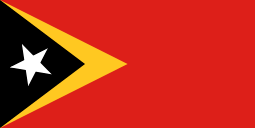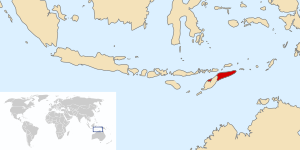Telecommunications in East Timor
| Telecommunications Democratic Republic of Timor-Leste | |
|---|---|
 | |
 | |
| 3,000[1] | |
| 103,000[1] | |
| ccTLD: | .tl |
| Calling code: | +670 |
Telephones
Following Indonesia's withdrawal from East Timor in 1999, the telecommunications infrastructure was destroyed in the ensuing violence, and Telkom Indonesia ceased to provide services. A new country code (670) was allocated to East Timor by the International Telecommunication Union, but international access often remained severely limited.
A complicating factor has been the fact that the calling code 670 was previously used by the Northern Marianas, with many carriers not aware that the code is now used by East Timor (the Northern Marianas, as part of the North American Numbering Plan, now uses the country code 1 and the area code 670).
Telephone calls are also often extremely expensive: for example, Telstra in Australia raised the cost of calls to East Timor to A$3.00 a minute from 97 cents in 2003. In the UK, BT's standard rate is over £2 a minute.[2]

Telstra expanded its cellular telephone signal into East Timor in 2000, and operated services until 2003, when Timor Telecom, 50.1% part-owned by Portugal Telecom, began operating fixed line and mobile telephone services. Until recently, the fixed line network was mainly confined to the capital Dili, although this has been expanded nationwide, to each district capital.
According to a press-release issued by Portugal Telecom, the total number of fixed phones (landline) are 3,000 and mobile cellular are 103,000 (as of June 2008). There is no broadband or ADSL service.
Portugal Telecom signed a 15-year contract in 2002 to invest US$29 million to rebuild and operate the phone system. The contract could be extended by 10 more years, totaling 25 years of monopoly. 2003 gross revenue totaled €10.5 million.
All voice and data are carried out by Intelsat, using a direct satellite link with one hop to their downlink in Portugal.
The telephone system suffered significant damage during the violence in the East Timorese independence. As a result, there is very little fixed-line service, and mobile-cellular service and coverage are limited primarily to urban areas.[3]
Timor Telecom offers mobile GSM services covering approximately 92% of the population,[4] 100% of the districts, and 57% of the sub-districts.[5][6]
International service is available in major urban centers, but not much elsewhere.[3]
On January 17, 2013, the Prime Minister of Timor Leste, Mr Xanana Gusmao, launched Telkomcel as the second telecommunication operator in Timor Leste with three main services: (1) Mobile Services, (2) Corporate Solution dan, (3) Wholesale & International Services. Telkomcel is 100% owned by PT Telekomunikasi Indonesia International (TELIN).
Radio
There are at least 21 radio stations in East Timor.[3] The main station is Radio Timor Leste, broadcasting in Tetum, Portuguese and Indonesian. Other radio stations include Radio Kmanek, and Radio Falintil, and Radio Renascença, while there are also FM retransmissions of RDP Internacional from Portugal, Radio Australia, and the BBC World Service. Community radio stations broadcast around the country, in regional languages such as Tokodede and Fataluku.
Television
East Timor has one national public broadcaster,[3] Televisão Timor Leste or Televizaun Timor Lorosae, which broadcasts local programming in Tetum and Portuguese, as well as retransmissions of RTP Internacional from Portugal.
In May 2007, RTTL's television and radio services became available via satellite, using a transponder leased from Telkom Indonesia.[7][8]
In February 2009, TVTL began carrying programmes from Rede Globo in Brazil.[9]
INTERNET
The first Internet connection in East Timor was made by the United Nations APDIP Programme in 1999 to support UNTAET, the UN Transitional Administration. This consisted of a C Band link to Singapore Telecom. The initial bandwidth was 256kbit/s.[10]
The Internet country code for East Timor is .tl. This code was officially changed from .tp (for Portuguese Timor) when the country achieved its independence on 20 May 2002.
There is only one ISP in East Timor, Timor Telecom. Two-way Satellite Internet is in theory available, as the country falls within the Australian and Asian footprints of several satellites offering this service, however in practice licences are not granted for use of non-East Timorese Telecom services. Therefore, internet services include landline ADSL connections, dedicated line infrastructure and 3G cellular internet.[11]
As of 2015, 13.4% of the population were connected to the internet[12] with the vast majority of users using cellular internet.[13] According to Timor Telecom about 94% of the population is able to access cellular phone and internet services.[14]
Timor Telecom has sought to block some Voice over IP services on its network such as Skype.[15] As a result, some such services may not function.
Censorship
There are no government restrictions on access to the Internet or credible reports that the government monitors e-mail or Internet chat rooms. The law prohibits arbitrary interference with privacy, family, home, or correspondence and the government generally respects these prohibitions in practice.[16]
References
- 1 2 Portugal Telecom press-release from Aug 2008
- ↑ "UK International Prices: Tariff Guide for Residential Customers" Archived 2012-01-11 at the Wayback Machine., BT, 1 June 2011. Retrieved 26 December 2013.
- 1 2 3 4 CIA World Factbook, 2009: East Timor
- ↑ Administrator. "Timor Telecom". www.timortelecom.tl. Archived from the original on 2016-01-07. Retrieved 2016-02-03.
- ↑ "map of mobile coverage". timortelecom.tp. Archived from the original on 15 July 2009. Retrieved 26 April 2018.
- ↑ "Timor Telecom: Mobile Services". timortelecom.tp. Archived from the original on 15 July 2009. Retrieved 26 April 2018.
- ↑ "TELKOM - PT. Telekomunikasi Indonesia Tbk". telkom.co.id. Archived from the original on 2011-07-21.
- ↑ "Archived copy". Archived from the original on 2011-01-04. Retrieved 2015-09-11.
- ↑ "WorldScreen.com - Archives". worldscreen.com. Archived from the original on 2009-02-24.
- ↑ Arnold, Wayne (1999-12-27). "U.N. Agency Is Bringing Timor Online (Horsemen in Mongolia, as Well)". The New York Times. ISSN 0362-4331. Archived from the original on 2017-03-29. Retrieved 2017-03-28.
- ↑ "Timor Telecom". www.timortelecom.tl. Timor Telecom. Archived from the original on 9 July 2017. Retrieved 4 June 2017.
- ↑ "Percentage of Individuals using the Internet". Statistics. International Telecommunication Union. Archived from the original on 22 July 2017. Retrieved 4 June 2017.
- ↑ "Fixed-broadband subscriptions". Statistics. International Telecommunication Union. Archived from the original on 19 May 2017. Retrieved 4 June 2017.
- ↑ "Timor Telecom". www.timortelecom.tl. Timor Telecom. Archived from the original on 4 September 2017. Retrieved 4 June 2017.
- ↑ Logan, edited by Indrajit Banerjee, Stephen (2008). Asian communication handbook 2008. Singapore: Asian Media Information and Communication Centre and Wee Kim Wee School of Communication and Information, Nanyang Technological University. p. 506. ISBN 9789814136105. Retrieved 4 June 2017.
- ↑ "Timor-Leste" Archived 2017-05-16 at the Wayback Machine., Country Reports on Human Rights Practices for 2012, Bureau of Democracy, Human Rights and Labor, U.S. Department of State, 22 March 2013. Retrieved 26 December 2013.

